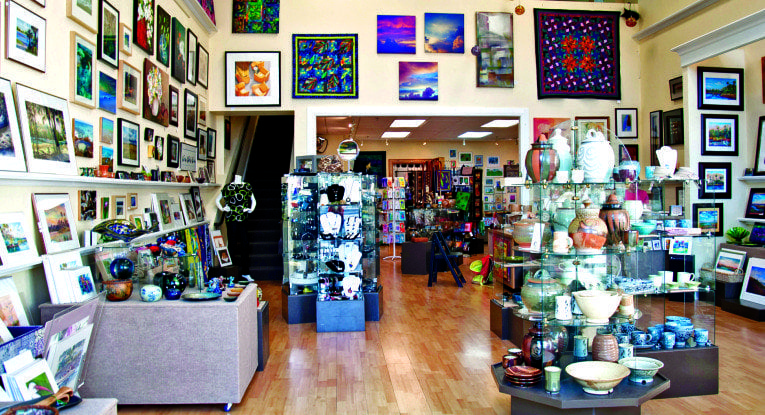
By Jing Jin
Like other successful business stories, this story begins with a meeting. In this case, the meeting wasn’t at a coffee shop or in a garage, but in a museum.
In October 1970, Jim Brown, Miriam Greenfield and Dick Beardsley got together at the Samuel P. Harn Museum of Art to brainstorm the possibility of establishing an artists’ cooperative. They did not know it would turn into a nonprofit business that would continue for more than 40 years.
Artisans’ Guild Gallery, located at 201 SE 2nd Place in downtown Gainesville, has moved seven times in its history. The original spot was a building on Southwest University Avenue that was scheduled to be demolished. “All we wanted was to get things going,” Beardsley says.
Brown, a University of Florida professor who had studied co-ops in the late ’60s and early ’70s, proposed the co-op to unite local artists in marketing their work.
“No one had enough money to open up a store,” Beardsley says. “Jim talked to some of the artists in Gainesville. One of them, Miriam, told me it was a good idea to save money, and then we had the meeting at the museum.”
The economy has had ups and downs, but the guild has kept going. Only five of the original 27 members remain on today’s artist list. The guild’s roster has grown to more than 60 artists, and the art includes pottery, fiber, jewelry, painting, wood and leather.
Joyce Dewsbury, who has been a member of the guild for 34 years, says she relies on gallery as the primary place to sell her art.
“A lot of us have our own studios, but we don’t necessarily sell our work out of it,” she says. “They’ll have a show at the studio sometime during the holidays. We usually don’t have a place at house to exhibit.”
Jeanne Van Spijker, a guild member for 20 years, says it is much more convenient for an artist to join the guild than to open up a self-owned gallery.
All the artists at the guild share equal working time and earn the same percentage, generally 30 to 35 percent from each sale, which is well below what most private galleries charge according to Abe Sloan, a wood turner in the guild.
“The guild only takes the percentage to cover the minimum cost, like to pay the rent and utilities, or to fix the plumbing,” Beardsley says.
The artists take shifts working the gallery, with most artist working four hours monthly.
The guild doesn’t have management costs. “We have different committees made up from our members in charge of different jobs like advertising, displaying and maintenance,” Beardsley says.
Van Spijker recalls, “The guild experienced its peak all through1980s and 1990s, which coincides with the economy.”
“We had customers who kept coming back, especially for gifts. There was a nice variety in the gallery and some of the artists were quite productive during those 20 years,” says Beardsley.
Artists profited. “Everybody was making a living wage,” Beardsley says. “No one would consider that he or she was rich, but I, myself, got to build my own house. We knew how to stretch the money and not feel poor or deprived.”
Artisans’ Guild Gallery is still trying to recover from the financial challenges it encountered two years ago, a time when the gallery was located at the Millhopper Shopping Center.
The gallery is attracting a younger and more knowledgeable clientele now that it has moved downtown. “People in Gainesville are quite receptive of the arts, and we have a nice space here to display everybody’s work,” Beardsley says.
Forty years since its founding, Artisans’ Guild Gallery holds onto its goal to help lower the costs for artists and making their work known to more people. It holds a theme show each month featuring one of the in-house artists.
Van Spijker sees optimistic about the future. “During the 1990s, people were trying to get rid of the mass produced things. It’s kind of what we are going through right now. It’s like a renaissance, wanting handmade versus mass produced items.”






